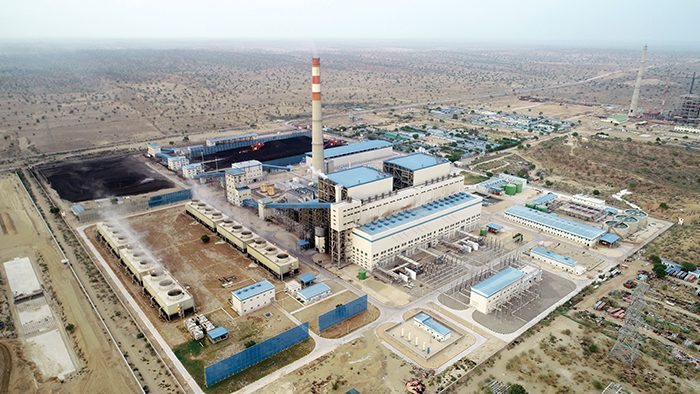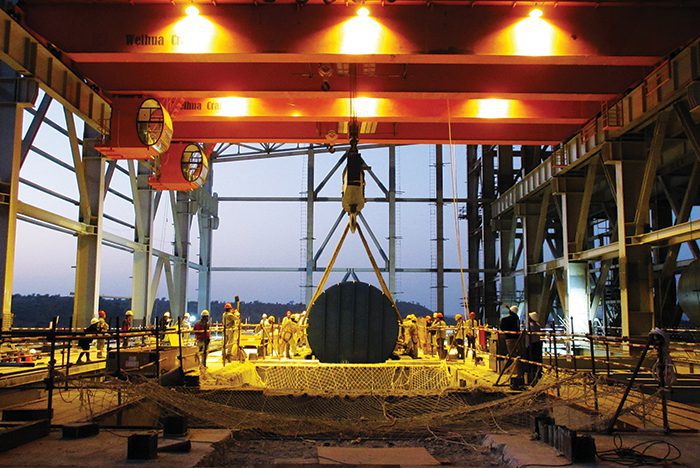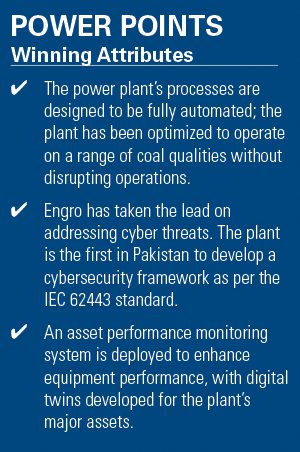Cause for Celebration–Plant Provides Power, Economic Boost to Pakistan
 |
The Engro Powergen Thar Ltd. power station is transforming a desert region that has long sought reliable electricity to support its economy, create jobs, utilize an abundant natural resource, and help solve an energy crisis.
The importance of a coal-fired power plant to an entire region, and to a country, was highlighted in Pakistan earlier this year. It’s not often that government officials and the general public come together to celebrate an energy project, but in this case, there was plenty of excitement about how the Engro Powergen Thar Ltd. (EPTL) facility is enabling Pakistan to take advantage of its natural resources, and provide economic opportunities and support for a harsh desert region considered a difficult place to live.
The EPTL plant utilizes Thar coal—which the country has in abundance in the Tharparkar region—to generate electricity. Officials say it will make Pakistan, a country that has faced electricity shortfalls for years, more energy secure, and provide a viable solution to an ongoing energy crisis.
The realization that the country’s reserves of lignite coal can be used in a domestic power plant prompted a three-day festival in March, and has led Pakistani officials to call the EPTL facility transformational for the country’s future. It’s among the many reasons POWER has chosen EPTL as a Top Plant in the coal-fired category.
“The proof of concept that electricity can be produced from Thar coal has been demonstrated successfully by EPTL, [and] it is the first plant to utilize this lignite coal for production of electricity,” said Syed Manzoor Hussain Zaidi, CEO of EPTL.
State-of-the-Art Equipment
The EPTL plant, located about 280 miles southeast of Karachi in the Sindh province of Pakistan, is what Pakistani officials call a first-of-its-kind mine mouth power plant, using indigenous Thar coal—the first power generation facility to do so. It is equipped with two 330-MW circulating fluidized bed boilers, along with an innovative three (steam-cooled) cyclones arrangement, with once reheat, two cylinders, two flow exhausting, single-axial and condensing steam turbine generators. The plant has what operators consider state-of-the-art environmental control systems, including electrostatic precipitator technology, which helps the plant meet the International Finance Corp.’s (IFC’s)—a subsidiary of World Bank—emissions guidelines.
The plant’s equipment and other facilities have been designed to function safely and smoothly in a harsh desert environment—for example, ambient temperatures as high as 50C (122F), with excessive dust. The plant also has a laboratory equipped with state-of-the-art equipment to ensure that the quality of coal being utilized meets the design specifications and safety requirements.
Officials said that advanced control strategies such as a robust distributed control system (DCS) have been implemented to ensure EPTL is a fully automated plant. Despite the variable coal quality from the mine, which is a big challenge for the plant, control loops have been optimized to ensure efficient operation. Officials said that alarm rationalization was recently performed as per the International Society of Automation (ISA) 18.2 standard; after which, the recurring alarms were reduced by 99% and alarms per operator per hour are less than 12.
The company also told POWER that several digitization initiatives support EPTL’s reliability. The DCS provides data to GE Power’s Monitoring and Diagnostics Center in Atlanta, Georgia, where it can be analyzed by experts. A solution provided by SAP is being implemented to control and ensure better visibility of business processes. An initiative also has been launched to develop a cybersecurity framework, and carry out a gap analysis as per the ISA/IEC 62443 standard.
Plant officials tout that the power plant is compliant to IFC and national emissions standards, with a safety management system “inspired by OSHA [Occupational Safety and Health Administration] and DuPont PSM [Process Safety Management], which makes it one of the safest plants in terms of process and personnel safety.” It also is an ISO 14001 certified site, “with one of the most effective environment management systems in Pakistan.”
Other companies involved with the project include Dongfang, a Chinese steam turbine equipment manufacturer; FAM Germany (coal crushers); and China’s TBEA (transformers) and Xian (switchgear). Gardner Denver Nash Machinery and Nantong Dart-Polrich supplied fans. GE and Siemens supplied digitization solutions and control systems. Other equipment came from Emerson (instruments) and SWAN (analyzers); Rotork, Fisher, Flowserve, and Masoneilan supplied valves.
Along with its automation, and optimization “to operate on variable coal qualities without disrupting the process,” plant officials told POWER that Engro is also aware of the changing landscape in cyber threats and has taken the lead in Pakistan by being the first plant to develop a cybersecurity framework as per the IEC 62443 standard. Moreover, a comprehensive cybersecurity risk assessment is being carried out to identify immediate risks and develop risk mitigation strategies.
The officials said EPTL is taking the lead in the digital transformation with some key projects, including an asset performance monitoring system expected to further enhance equipment performance. The plant’s major assets, including steam turbines and boilers, will have digital twins developed, and alerts will be generated to predict/prevent failures and operate the assets at their optimal conditions, they said.
Transforming a Region
EPTL is a subsidiary of Engro Energy Ltd.—which is the integrated energy vertical of Engro Corp.—and regarded as one of Pakistan’s largest conglomerates. The EPTL plant was conceived as part of the Thar coal mine and power projects with the goal of establishing a two-unit, 660-MW power project in Thar Block II, Sindh, Pakistan. EPTL is a joint venture among Engro Powergen Ltd., China Machinery Engineering Corp., Pakistan’s Habib Bank Ltd., and Liberty Mills Ltd., a Karachi-based industrial textile company.
 |
|
1. Workers install the generator stator in the Engro Powergen Thar Ltd. (EPTL) facility’s turbine hall during the construction phase of the project. Construction began in April 2016; EPTL entered commercial operation on July 10, 2019. Courtesy: EPTL |
Construction (Figure 1) of the power plant began in April 2016, and it entered commercial operation on July 10, 2019, becoming the first project to generate electricity using indigenous lignite coal from the Tharparkar district. On the first day of this year’s Chinese festival, Li Bijian, the Chinese Consul General in Karachi, told attendees that there was now great investment potential in the region thanks to Thar coal, and said it would change Pakistan’s standing in the world.
“Under the China-Pakistan Economic Corridor projects we have successfully completed the first phase and now we are entering the second phase,” he said. Bijian noted that the mining and power projects in Thar had created thousands of jobs for the local population. “Thar is a beautiful place and it has tremendous investment potential in all spheres. Let us work together to make Thar more beautiful and developed.”
Mohammed Nawaz Soho, deputy commissioner for Tharparkar, said the desert region’s history and traditions were being discovered thanks to the project’s success. “We have achieved our goal to present [the] beautiful face of Thar by arranging this event in collaboration with coal mining companies and NGOs [non-governmental organizations],” he said. Rana Hamir Singh, a leader of the Pakistan Peoples Party, said the region would change the fate of Pakistan through the use of its coal.
 |
Community Involvement
The plant has proven to be important to the surrounding community in more ways than providing electricity. The workforce—735 plant employees, including 683 full-time workers—is comprised of local residents. Manzoor told POWER “it is the company’s core value to uplift the local residents and community so that they can get the benefit from the economic activity happening in their neighborhood.”
The company arranged a training program for 75 Pakistani engineers, who spent at least six months working with Chinese experts in classroom training, simulator training, and on-site training on similar power plants in China. After training, those engineers were made permanent plant employees to perform operations and maintenance activities. The training program continues, and the Chinese contractor eventually will replace its personnel at EPTL with Pakistani workers.
The plant also helped set up a solar lighting project for the surrounding community. Manzoor said most of the villagers don’t venture outside at night, in part due to numerous snakes and a lack of light. “But sometimes it is inevitable for villagers to come out for some work,” he told POWER. “In that situation they had to use torches. The villagers had requested the company to help them with this problem of power; the company accepted the request and installed solar lights in the village. The villagers are thankful and happy since the installation has improved quality of life and provided economic opportunities to the residents of the village.”
Manzoor also noted other projects where the plant supports the region. “The livelihood of most of the local people runs on two things: cultivation and animal breeding. As Tharparkar is desert, most cultivation is dependent on rainwater and that is not in human control. So most of the poor people depend on animal breeding, their milk and by-products. Sometimes due to lack of funds for proper vaccination most of their animals die. Therefore, the company had thought to support them with the vaccination of animals, and the majority of the villagers had appreciated this act of kindness.” As part of the effort, the company is also building ponds to provide drinking water for animals—another part of the EPTL project’s major socio-economic impact. ■
—Darrell Proctor is a senior associate editor for POWER (@POWERmagazine).